Table of contents
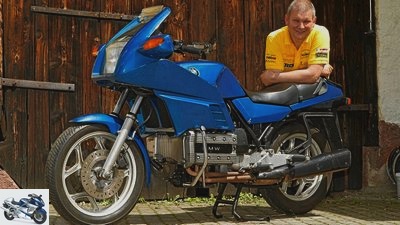
Photos: Bilski
Sports & scene
Motorcycle transport of the BMW K 100 RS to the GDR
Adventurous motorcycle transport of the BMW K 100 RS to the GDR
German-German friendship
Content of
Jurgen Kuhnle remembers a very personal chapter of German-German history here. In 1985 the Swabian brought this blue BMW K 100 RS to his friend in East Berlin.
Jurgen Kuhnle
11/01/2013
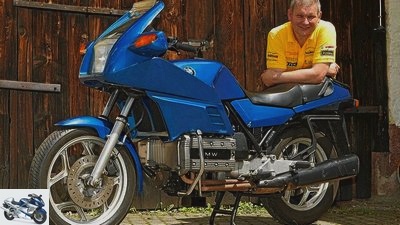
Bilski
Jurgen Kuhnle brought the blue BMW K 100 RS to his friend in East Berlin in 1985.
Even today my heart beats faster when I think back to April 25, 1985. As if it had only been yesterday, I feel the thick lump in my throat, my damp hands, which cling to the steering wheel of the Simca Rancho for support, see the anxious look of my wife Carolin at the sight of the iron curtain. “Never again the Eastern Bloc!”, She had sworn to me two years earlier, after we had been harassed with our team on the Czech border.
And yet that day we drove a rental van to the inner-German border crossing in Herleshausen. Packed to the top with an almost new BMW K 100 RS, two new rear tires, two R 90/6 tanks in need of repair, a rusty Norton exhaust system, stacks of motorcycle magazines and various gift packages. Everything intended for my friend Hans-Henner in East Berlin. Weren’t we too naive after all when we embarked on this friendship service? Our initial thirst for adventure – what should happen to us? – was blown away when we stopped in front of the GDR border guard at lunchtime. I still remember exactly how I handed him our ID cards and the documents that Hans-Henner had sent us in the mail with slightly shaky hands and a friendly smile. It wasn’t long before the border guard came back from the checkpoint. Without a word he turned around the Simca, inspecting our cargo. Then he returned the papers and wished us a safe journey. Should that really have been all? We were totally perplexed, stones weighing several pounds fell from our hearts as we plunged into a world that was completely new to us with our unusual cargo.
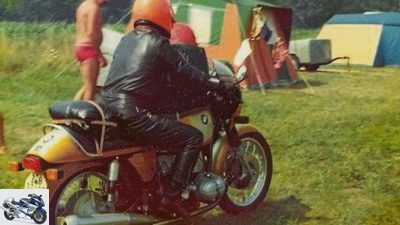
Bilski
Rare eye-catcher in the GDR: In front of the K 100 RS, Hans-Henner drove his BMW R 90 S to the annual motorcycle meetings in the CSSR.
In retrospect, this whole scene seems somehow unreal 28 years ago. At that time, after the less pleasant experiences with our motorcycle team on the Czech border, we did not believe that the entry into the GDR would go so smoothly. We were even allowed to choose our route to East Berlin freely and decided to visit Weimar and Wittenberg. The drive there was exclusively on country roads, it was like a journey through time. In the country, time seemed to have stood still. Cobblestones everywhere, huge potholes, many half-ruined houses. We lurched slowly forward, the tension giving way to curiosity. Which of course was mutual throughout the trip. I will never forget the incredulous faces of the friendly people at the sight of the BMW in our station wagon. Neither did the first contact with Hans-Henner.
That was at Whitsun 1983. A few months earlier I had first heard of a motorcycle meeting in Czechoslovakia at a team meeting. Actually a prohibited event. The authorities knew that the “Westerners” met with East German motorcyclists over Whitsun. That was possible because our politicians had simply forgotten about motorcyclists in the Eastern Treaties. The location of the meeting in Czechoslovakia was agreed orally year after year. In the early summer of 1983 it was Jesenice. Since the “mysterious East” had always interested me, I decided to go to this meeting. During the journey, my wife and I experienced firsthand the arbitrariness of the entry control of an Eastern Bloc state.
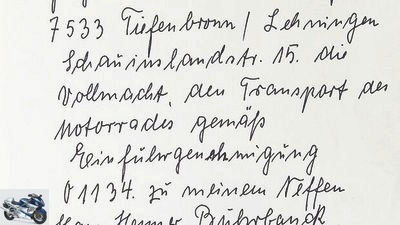
Bilski
Power of attorney for the transport. The prerequisite for importing the BMW was a donation from the aunt to her nephew, who, as the giver, also had to pay the import license fee of 2,000 D-Marks.
About 500 meters from the border I wanted to photograph the sunset. But by the time I unpacked the camera, the sun had dipped behind the horizon. Although I hadn’t taken a photo, the border guard ordered me to completely cancel the film. Fortunately, the rest of the journey to our destination, a campsite in Jesenice, went without incident. What sticks in my mind, however, are the run-down houses and the people who made a frustrated impression on me.
At the campsite we were already expected by the team warrior who had told me about these “conspiratorial” meetings. He introduced us to all participants. I noticed a BMW R 90 S in Daytona orange with GDR license plates. It was Hans-Henner’s machine that I quickly came into contact with. Throughout the weekend, he patiently answered all of my questions about life beyond the Iron Curtain. However, we only talked while we were running; his fear was too great that someone might overhear.
Even before the Wall was built, Hans-Henner drove a 500 series BMW. As the owner of a West motorcycle, he was able to submit applications to procure spare parts in the West. This is how he got his R 90 S. He first submitted an application for a chassis. And then another application for an engine. At the same time, a trusted person in the west had to purchase an R 90 S for him. The engine was removed and sent to the GDR, later the rest of the coveted BMW, which was finally completed in the home garage. Approval was possible with the appropriate documents. The R 90 S was Hans-Henner’s pride and joy. And he enjoyed having something “very special” with her.
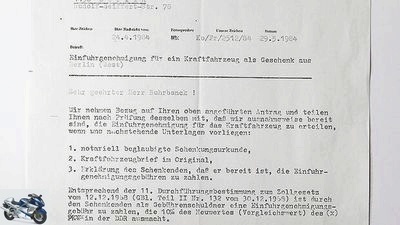
Bilski
Bringer of foreign currency: The Ministry of Foreign Trade levied a license fee of 2,000 D-Marks for importing the K 100!
From the beginning a deep friendship developed. At the next meeting in 1984, Hans-Henner told me about his wish to swap the R 90 S for the brand new BMW K 100 RS. And indeed, in the spring of 1985 he called me and asked if I could pick up a young, used K 100 RS from his friend in Frankfurt and transfer it to East Berlin. Spontaneously I said yes, at the time I found this unusual activity a delightful adventure.
First, however, other people had to become active. Hans-Henner’s friend Klaus from Frankfurt, of course, who bought the blue BMW K 100 RS with his money. Then Hans-Henner’s aunt from West Berlin obtained a donation from the notary from BMW in favor of her nephew. Hans-Henner himself had already applied for the import permit a year earlier, which was exceptionally approved by the Ministry of Foreign Trade after the giver had also agreed to pay the import permit fee of 2,000 D-Marks. In addition, Hans-Henner’s aunt issued me a handwritten authorization for the transport of the BMW.
Until we were finally able to heave the machine into the Simca Rancho in April 1985 (which was only possible with the front wheel removed), it was about a year that was associated with an enormous amount of paperwork for my East Berlin friend. Telephoning was too hot for him, so everything was planned and clarified in lengthy letters.
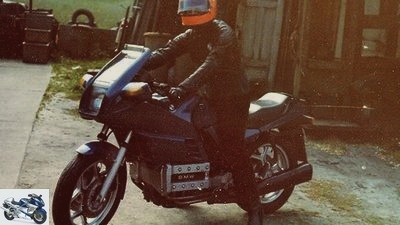
Bilski
BMW and owner after the GDR registration.
When we finally arrived in East Berlin on that memorable April evening, Hans-Henner was eagerly waiting for “his” BMW. The K was immediately put in the garage, no one should see it. I will never forget his emotion, his joy over the actually inaccessible motorcycle during the first seat test. Nor were the days in East Berlin when we were able to experience everyday life in the GDR up close. On the first day we drove halfway through town to organize some turkey schnitzel somewhere. I don’t know what our friend had to do for it. Money alone was not enough. Rather, bartering flourished in secret, as a kind of second currency. The next day, Hans-Henner stood in line for eight hours to get “authorization cards” for the newly opened theater. And on Saturday, to our astonishment, he invited a pastor friend to watch the Bundesliga reports on the sports show. It was his way of somehow maintaining contact with the West alongside the motorcycle meetings in Czechoslovakia. The farewell on Sunday was a particularly sad one. We were allowed to go back, but we had to leave Hans-Henner and his wife in this cage. Little did we know at the time that the wall would fall four and a half years later.
For me, the last meeting was in Czechoslovakia in 1985, while Hans-Henner continued to go there every year with his K 100 RS. The fall of the Berlin Wall in 1989 meant a huge gain in personal freedom for him, but for his K 100 RS it also meant the loss of its exclusivity in a united Germany. Nevertheless, Hans-Henner remained loyal to his blue K 100 RS, cherished and nurtured it, as well as our friendship.
It has lasted for almost 30 years. But time will not pass anyone by without a trace. Not even a big motorcycle love. In the last few years, Hans-Henner was getting more and more troublesome with the lush pounds of his loyal companion. Last spring he finally made the difficult decision to sell his K 100 RS. And again it was me who was supposed to take care of it. When I was in Berlin on business last May, at our evening meeting I did not yet have the feeling that I should take his motorcycle “to the West” again. He had one last night to reconsider his decision.
The next morning, however, it was finally decided and we loaded the BMW into my van. Then I was given a power of attorney again. This time not for the transport, but for the sale of the K 100 in his name. Together with all the documents that record this eventful history in black and white.
Related articles
-
Portrait of a motorcycle enthusiast
Detlev Louis motorcycles Portrait of a motorcycle enthusiast Portrait of a motorcycle enthusiast The person behind Detlev Louis Dozens of shops bear his…
-
Motorcycle tour through Algeria
to travel Motorcycle tour through Algeria Motorcycle tour through Algeria The dunes of the Sahara Algeria. The grave road, the sand dunes from Erg…
-
Spotlight on motorcycle production, part 3: BMW
Bilski 13th pictures Bilski 1/13 A location with tradition – the oldest halls of the Spandau plant have been in existence since 1928, and since 1939 it…
-
clothing Classic motorcycle equipment Classic motorcycle equipment Legend without end? Fackelmann station wagon, Elefantenboy, Pichler disguise: What…
-
“Across Borders” – film of a long motorcycle trip
streetsfilm 21 pictures streetsfilm 1/21 Margot and her film team: Paul Hartmann and Johannes Meier. streetsfilm 2/21 The first breakdown occurred in…
-
Motorcycle transport solutions Caravans, mobile homes, trailers, transport systems Herder to travel Motorcycle transport guide Motorcycle transport guide…
-
Travel: Halfway around the world by motorcycle
archive 15th pictures Hofmann 1/15 Steven’s Way of Life: The twelfth part takes Steven over Nepal’s bridges, mountains and valleys. Hofmann 2/15 The…
-
Schulz to travel Motorcycle world tour Motorcycle world tour 50,000 kilometers home Many dream of the great journey, the trip of a lifetime. At some…
-
Motorcycle trip in the Ardennes
Deleker to travel Motorcycle trip in the Ardennes Motorcycle trip in the Ardennes Seize the opportunity Full of sun. And that in autumn and on a weekend….
-
Motorcycle trip through Mexico
Jo Deleker 34 pictures Jo Deleker 1/34 Out and about in Mexico. Jo Deleker 2/34 There aren’t that many in Mexico anymore, so everyone has to be in the…